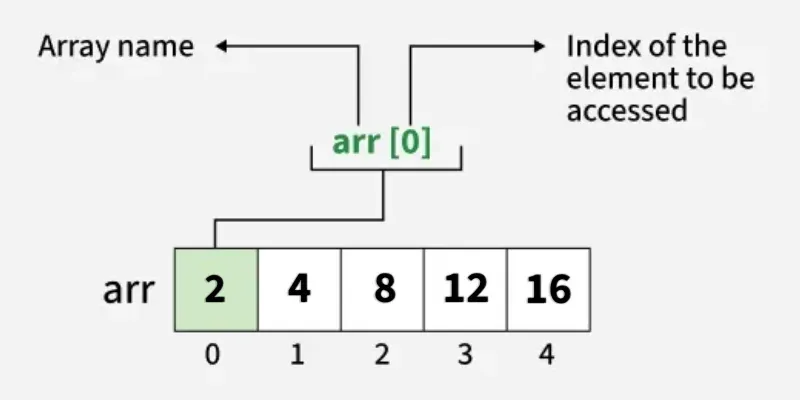An array is a linear data structure that stores a fixed-size sequence of elements of the same data type in contiguous memory locations. Each element can be accessed directly using its index, which allows for efficient retrieval and modification.
C #include <stdio.h> int main() { int arr[] = {2, 4, 8, 12, 16, 18}; int n = sizeof(arr)/sizeof(arr[0]); // Printing array elements for (int i = 0; i < n; i++) { printf("%d ", arr[i]); } return 0; } The below image shows the array created in the above program.

To understand the key characteristics of arrays such as fixed size, contiguous memory allocation, and random access. Refer to this article: Properties of Arrays
Creating an Array
The whole process of creating an array can be divided into two primary sub processes i.e.
1. Array Declaration
Array declaration is the process of specifying the type, name, and size of the array. In C, we have to declare the array like any other variable before using it.
When we declare an array in C, the compiler allocates the memory block of the specified size to the array name.

2. Array Initialization
When the array is declared or allocated memory, the elements of the array contain some garbage value. So, we need to initialize the array to some meaningful values.
- We can skip mentioning the size of the array if declaration and initialisation are done at the same time.
- We can also partially initialize while declaring. In this case, the remaining elements will be assigned the value 0 (or equivalent according to the type).
Accessing Array Elements
Array in C provides random access to its elements, which means that we can access any element of the array by providing the position of the element, called the index.
 C
C #include <stdio.h> int main() { // array declaration and initialization int arr[5] = {2, 4, 8, 12, 16}; // accessing element at index 2 i.e 3rd element printf("%d ", arr[2]); // accessing element at index 4 i.e last element printf("%d ", arr[4]); // accessing element at index 0 i.e first element printf("%d ", arr[0]); return 0; } Update Array Element
We can update the value of array elements at the given index i in a similar way to accessing an element by using the array square brackets [] and assignment operator (=).
C #include <stdio.h> int main() { int arr[5] = {2, 4, 8, 12, 16}; // Update the first value // of the array arr[0] = 1; printf("%d", arr[0]); return 0; } C Array Traversal
Array Traversal is the process in which we visit every element of the array in a specific order. For C array traversal, we use loops to iterate through each element of the array.
 Traversing An Array C
Traversing An Array C #include <stdio.h> int main() { int arr[5] = {2, 4, 8, 12, 16}; // Print each element of // array using loop printf("Printing Array Elements\n"); for(int i = 0; i < 5; i++){ printf("%d ", arr[i]); } printf("\n"); // Printing array element in reverse printf("Printing Array Elements in Reverse\n"); for(int i = 4; i>=0; i--){ printf("%d ", arr[i]); } return 0; } OutputPrinting Array Elements 2 4 8 12 16 Printing Array Elements in Reverse 16 12 8 4 2
Size of Array
The size of the array refers to the number of elements that can be stored in the array. The array does not contain the information about its size but we can extract the size using sizeof() operator.
C #include <stdio.h> int main() { int arr[5] = {2, 4, 8, 12, 16}; // Size of the array int size = sizeof(arr)/sizeof(arr[0]); printf("%d", size); return 0; } The sizeof() operator returns the size in bytes. sizeof(arr) returns the total number of bytes of the array. In an array, each element is of type int, which is 4 bytes. Therefore, we can calculate the size of the array by dividing the total number of bytes by the byte size of one element.
Note: This method only works in the scope in which the array is declared. Refer to this article to know more - Length of Array in C
To know how to pass an array to a function in C, refer to this article — Arrays and Pointers
For working with tables, matrices, or grids, C allows the use of arrays with more than one dimension. To learn more, refer to this article — Multidimensional Arrays in C.
Practice Array Problems
The following problems helps you to improve your efficiency in using C array:
Explore
C Basics
Arrays & Strings
Pointers and Structures
Memory Management
File & Error Handling
Advanced Concepts
My Profile